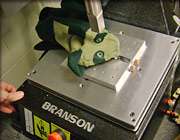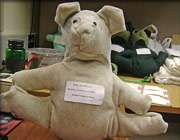Student-Made 'Sustain-a-Bear' Puts Green Spin on Timeless Toy

Most teddy bears, regretfully, face a lonesome retirement once their owners grow up or move on.
With few parents wanting to purchase second-hand teddy bears, and no quick or easy way to sanitize or recycle the toys, most teddies and other plush animals inevitably end up relegated to basements, attics, and landfills.
This somber treatise on product lifecycles motivated three Rensselaer Polytechnic Institute students to create Sustain-a-Bear. The plush bear, developed as a class project, tackles the challenge of infusing a new, green consciousness into every stage of the teddy bear production timeline, from sourcing raw materials to manufacturing, use, and disposal. The team’s hard work garnered first place in the recent 2009 Manufacturing Student Design Competition held by the American Society of Mechanical Engineers (ASME).
Made out of fleece sourced from recycled PET plastic, Sustain-a-Bear is inexpensive to produce, easy to assemble, fully recyclable, and undeniably cuddly. In place of thread and glue, the assembly process uses ultrasonic welding, which employs heat and vibration to bond together the seven pieces of fabric that comprise a Sustain-a-Bear. This lack of adhesives and stitching, paired with the fact that the bear is stuffed with scraps of the same fleece from which its exterior is made, means a Sustain-a-Bear at the end of its days can be tossed in the recycling bin and easily find a second life as brand-new bear. (Or maybe a soda bottle.)
The Sustain-a-Bear team is mechanical engineering doctoral students Christina Laskowski and Todd Snelson, along with mechanical engineering senior Saadia Safir, working under the guidance of Associate Professor Daniel Walczyk and Professor Michael Jensen from Rensselaer’s Department of Mechanical, Aerospace, and Nuclear Engineering. The group has filed a provisional patent, and plans to pursue a full patent in preparation for one day commercializing or licensing this new technology.
“We tried to pick an idea that would have a big impact,” Laskowski said. “The teddy bear market is huge, and despite all the billions of dollars of sales every year, no one has really looked into manufacturing stuffed animals in a sustainable way. That’s where the idea for Sustain-a-Bear was born.”
The team went through several iterations of Sustain-a-Bear, from the initial, one-color, hand-sewn prototype, Alpha, comprised of 19 individual parts, to its more advanced, ultrasonically welded, and considerably cuter cousin, Epsilon, who is made from seven distinct parts. Along with Sustain-a-Bear’s recyclable nature, the team said manufacturing the bears requires little water, and takes about the same time to produce as a stitched bear of the same size but uses 90 percent less energy. The low cost and quick manufacturing time should enable economies of scale attractive enough to mass-produce Sustain-a-Bears in the United States, the students said.

“It’s hard to know what to do with old teddy bears, because they’re difficult to clean, they get damaged when you wash them, and they usually end up in a landfill,” Snelson said. “We wanted to make a bear that didn’t end up in landfills, something that still had utility at the end of its product life.”
The team of students presented their Sustain-a-Bear project at the annual ASME Manufacturing Science and Engineering Conference (MSEC) conference in October, and took first prize in the Manufacturing Student Design Competition. In addition to the sustainable manufacturing process, low cost, and ease of recycling, the team showed that the bears are durable, can be machine washed, are stain resistant, and melt rather than burn when exposed to fire. Overall, the team is confident that Sustain-a-Bear is competitive with conventional plush animal designs, results in a net energy savings, and can help to inject new, sustainability-minded thinking into the teddy bear industry. The students plan to continue refining their process and methods.
“Everything on the Sustain-a-Bear — its shell, face details, and stuffing — are made from the exact same material,” Safir said. “So instead of throwing out an old Sustain-a-Bear, you can just melt down the whole thing without having to separate any materials or pull out any stitching, and use it to create pieces of a new bear.”

The Sustain-a-Bear team was one of three student teams from Rensselaer to place as finalists in the national Manufacturing Student Design Competition, and presented at the MSEC conference. The Sustain-a-Bear project originated in Walczyk and Jensen’s Sustainability and Design course, and utilized facilities at the Rensselaer Center for Automation Technologies and Systems (CATS).
Walczyk, the primary faculty adviser of the Sustain-a-Bear project, said it is critical for young engineers and scientists to keep an eye toward recognizing opportunities for boosting sustainability, optimizing manufacturing processes, and correcting inefficiencies.
“New engineers have to understand that design must take a product’s entire lifecycle into account, including its impact on environment and ecology; employment and economics; as well as equity and equality,” he said.
Provided by Rensselaer Polytechnic Institute















